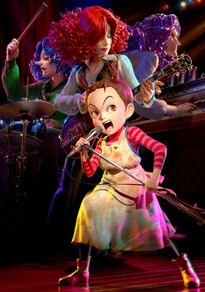Review
by Theron Martin,Earwig and the Witch
| Synopsis: |  |
||
In 1980s England, a woman who said she was fleeing from witches left her infant daughter, Earwig, at an orphanage with only a cassette tape to remember her by. Ten years later, the girl – renamed Erica Wig by the matron of the orphanage – feels she pretty much has the run of the orphanage and doesn't want to live anywhere else. That decision gets taken out of her hands when a strange couple chooses her despite her efforts to dissuade them. Erica finds herself as the “extra pair of hands” for a witch and an irritable demon-controlling fellow named Mandrake, but she quickly decides that she will learn to do magic and will eventually have the run of this house, too. |
|||
| Review: | |||
British author Diana Wynne Jones has had her work adapted into anime once before: she wrote the source novels for Howl's Moving Castle. The source for this movie, a short novel aimed at younger readers, was the last she finished prior to her death in 2011. Like Howl's Moving Castle, Earwig and the Witch became a Studio Ghibli project, but unlike its predecessor, it is directed by Goro Miyazaki and was reportedly made entirely by the studio's younger staff, with no direct input from the “old guys” of the studio. That may explain why it looks and feels dramatically different from any previous Studio Ghibli production. In fact, for better or worse, the movie does not look or feel like anime at all; the movie entirely uses Western-style 3DCG, and at a quality level comparable to Pixar. Characters have the rounded look and sense of depth and they move fluidly about a highly-detailed and textured environment with a good range of expressiveness. Minor weaknesses show here and there: heavily permed hairdos for humanoid characters tend to look stiff (although this could be a style point), and one late scene where Mandrake fully loses his cool is a bit underwhelming despite being one of the movie's featured visual spectacles. However, the setting detail work and color design are top-quality efforts, and that contributes to a very appealing look overall. The story is a classic “plucky orphan gets involved in weird stuff” plot, with Earwig being a spiritual cousin to Annie of Little Orphan Annie fame. She is quite the precocious girl, an avid reader of more advanced novels than her age but also quite capable of charming or manipulating people to her whims; she is fully convinced that she runs the show in the orphanage and can connive just about anyone to do her bidding given enough time. The portly witch Bella Yaga and the unnaturally tall, thin Mandrake become her new targets for domination, and this time we see the how she gets them under her thumb. Absolutely nothing weird fazes her much – not even discovering that the black feline Thomas can talk – and in the classic spirit of children's stories, she never seems to feel threatened or find herself at anyone's mercy despite being in what should be a very unsettling situation. She is the girl who will eventually be in charge, after all. The story progresses at a remarkably relaxed pace for a movie that is only 82 minutes in length only to wrap up too quickly. The few minutes ties up the plot at a breakneck speed. The final scene that should have been the set-up for an emotional reunion is a tepid meeting instead. Jones' untimely end means that sadly, there will probably never be a follow-up to a story that feels like just the beginning. The setting and the presence of magic have potential but are not elaborated upon. The music for the movie is provided by Satoshi Takabe, who previously collaborated with Goro Miyazaki on From Up On Poppy Hill and Ronja the Robber's Daughter. The score varies between light and jaunty and sentimental, exactly what would be expected for a movie clearly intended to be friendly to younger audiences. Older viewers might better appreciate the light rock numbers performed by Earwig's mother's band. One of the neater revelations – and biggest ironies – in the movie is how her mother is connected to Bella and Mandrake via the band, though that also could have used more elaboration. The movie is available in both subtitled and English dubbed forms. While most of the English cast has limited or no prior anime experience, the acting and lip flap timing are impeccable and the cast's British accents are credible; Taylor Paige Henderson, the young voice of Earwig, in particular is a real find. The Japanese cast members also have limited or no prior anime experience but sound no less appropriate, and the featured insert song is sung well in both languages. Despite hurrying things along at the end, Earwig and the Witch is a fine, entertaining work for all ages, one that would fall about in the middle of the pack as Western 3DCG productions go. |
| Grade: | |||
|
Overall (dub) : B+
Overall (sub) : B+
Story : B
Animation : A-
Art : A
Music : B+
+ Good use of 3DCG, strong voice acting in both languages |
|||
| discuss this in the forum (16 posts) | | |||
| Production Info: | ||
|
Full encyclopedia details about |
||